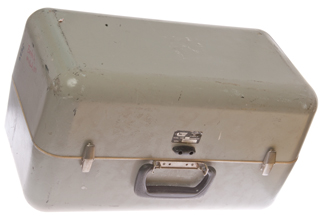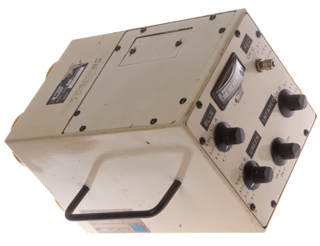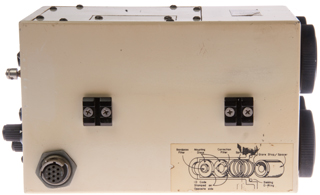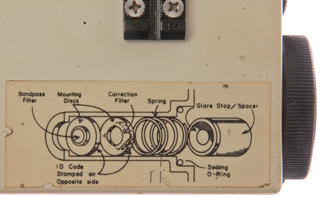Exotech 100BX Radiometer
© Brooke Clarke 2016
Description
Operation
Photos
Related
References
Patents
Links
Background
Got this because of my interest in optics and in particular in sensing different wavelengths. Optical Spectrum Analyzers are one way to do that but are bench instruments. This is a hand held instrument. I got a set of UAS-4 filters with the idea of making something very much like this, i.e. a filter then a diode to do simple spectral analysis.
The 100AX is an earlier version that may only have a single channel.
This instrument has narrwo band channels as opposed to the Eppley Pyranometer which has a very wide bandwidth.
Description
"Since 1973, the name Exotech has been synonymous with rugged, self-contained radiometers designed for use in the field environment. The 100BX Radiometer is a compact, lightweight, internal battery-powered instrument for incident or reflected radiation over the wavelength range of 0.4 to 1.1 µm. Four independent channels can be interchangeably fitted with filter sets that match the LANDSAT Multi-Spectral Scanner (MSS) bands, Thematic Mapper (TM) bands, SPOT bands, MODIS bands, or any other user-specified set of filters having center wavelengths within the effective range of the silicon photodiode detectors."
A Silicon photodiode has a spectral response of about 190 to 1100 nm (Wiki).
A light meter measures visible light, but when you are measuring something that includes light and either shorter or longer wavelengths it's called a radiometer (Wiki).
Was made to work with the Landsat Multi-Spectral Scanner (MSS) (Wiki), Landsat Thematic Mapper and Spot (Wiki) multi-spectral satellite systems. The four channels of the 100BX (A, B, C & D) can be configured with filters and field of view control optics and then used to measure both the incoming light in four bands or the light reflected from the Earth in those same bands. When this is done over some area it can be used to calibrate the satellite data.
Wavelength Table
Since the channel A filter is marked T. (Fig 9) I expect this unit is configured for Landsat Thematic Mapper.
Someone has added color names to the channels:
A: Blue
B: Green
C: Red
D: Infared (SIC) (this is near infrared, not thermal IR)
Filter Type Exotech Channel Satellite Channel Number Bandpass (microns) Landsat
Multi-Spectral Scanner
(MSS)
(Wiki)
A
B
C
DMSS 1
MSS 2
MSS 3
MSS 40.5 - 0.6
0.6 - 0.7
0.7 - 0.8
0.8 - 1.1Landsat
Thematic Mapper
(Wiki)
A
B
C
DTM 1
TM 2
TM 3
TM 40.45 - 0.52
0.52 - 0.60
0.63 - 0.69
0.76 - 0.90SPOT
(Wiki)
A
B
C
D- N/A -
SPOT 1
SPOT 2
SPOT 3- N/A -
0.50 - 0.59
0.61 - 0.68
0.79 - 0.89
This unit has a broken connector that needs repair, probably why it was sold on eBay for a very reasonable price.
Operation
The meter reads 0 to 1 mADC, but it seems that 0.6 mA is as high as it goes. So a fresh pair of 9V batteries reads 0.34. When the gain of a channel is switched up from X1 at some setting the meter peaks at 0.6. So if you see a meter reading of 0.6 switch down range for that channel.
There are only two wires coming from the dual 9V batteries, so the unit runs on 18 VDC, not +9 and -9 VDC. Maybe there's a circuit that provides positive and negative voltages for the internal op amps?
What photo diodes are used for each channel?
Photos
Related
Optics -
Optical Spectrum Analyzers -
References
Univ. of Nebraska - Lincoln: Exotech Hand-held 4-band Radiometer
Field Spectrometer & Radiometer Guide Remote Sensing Program, March 1999, University of Queensland - Professor Stuart Phinn - Remote Sensing Research Centre -
Milton, E.J. (1987) Principles of field spectroscopy, International Journal of Remote Sensing, 8(12):1807-1827Mowing Experiment Exotech Data (FIFE), May 27, 2010 - MSS filters
Goetz, A. F. H. 1992. Imaging spectrometry for earth remote sensing. In Imaging spectroscopy: Fundamentals and applications. ed. Toselli, F. and J.Bodechtel, 1-19.
Curtiss, B. and Goetz, A.F.H. (1994) Field spectrometry: techniques and instrumentation, In Proceedings of the International Symposium on Spectral Sensing Research, San Diego, July 10-15, pp, 195-203.
Surface Hydrology & Remote Sensing 1996 & 1998, Huntsville, NASA
Performance of Three Reflectance Calibration Methods for Airborne Hyperspectral Spectrometer Data - 2009
Patents
3553462 Apparatus for determining the radiation scattering properties of a fluid, Johnson Dennis F, Exotech, 5 Jan 1971, 250/565, 356/343 - particles suspended in fluid (includes air) but not this device.
4495416 Remote sensing instrument, Ross S. Mason, Peter J. Ellis, 22. Jan. 1985, 250/338.1, 250/342 -
instrument for Landsat ground based measurements, similar optical stack supports 1 deg or 20 deg FOV (See Fig 9 above)
1
Tube
3
Very small aperture (maybe 0.05x0.05")
5
Silicon Photodiode Detector in TO-5 package
7
large aperture
9
small penumbra 11
clip-on lens plate 13
plane glass window (alternate to lens 11) (glass loss equalization) - optional translucent screen 15
protective window 17
baffle 19
band-pass filter 21
plug-in capsule centers (aligned and attached to) photodiode
23
alloy detector centering ring
Links
PRC68, Alphanumeric Index of Web pages, Contact, Products for Sale
Page Created









